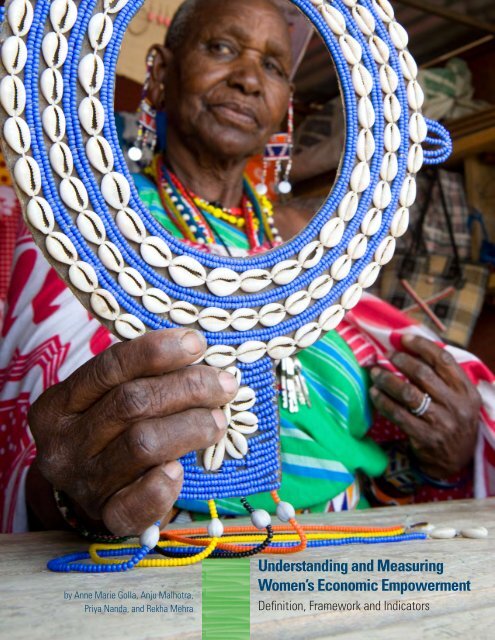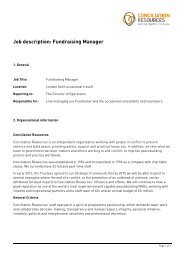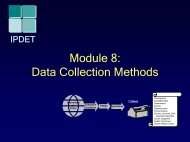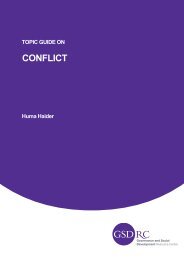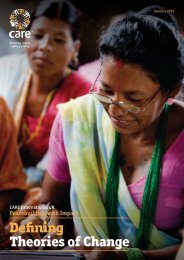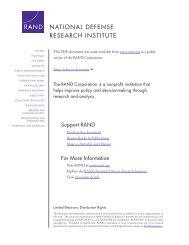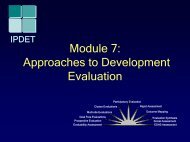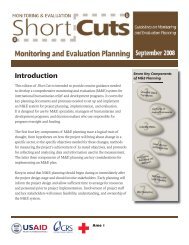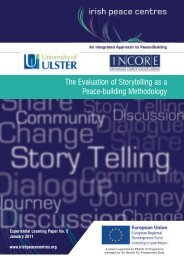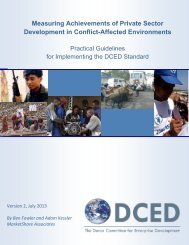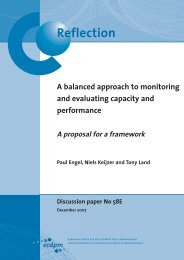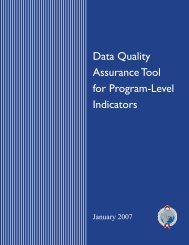Understanding and measuring womens economic ... - ICRW
Understanding and measuring womens economic ... - ICRW
Understanding and measuring womens economic ... - ICRW
You also want an ePaper? Increase the reach of your titles
YUMPU automatically turns print PDFs into web optimized ePapers that Google loves.
Definition, Framework <strong>and</strong> Indicatorsby Anne Marie Golla, Anju Malhotra,Priya N<strong>and</strong>a, <strong>and</strong> Rekha Mehra<strong>Underst<strong>and</strong>ing</strong> <strong>and</strong> MeasuringWomen’s Economic EmpowermentDefinition, Framework <strong>and</strong> Indicators
2<strong>Underst<strong>and</strong>ing</strong> <strong>and</strong> Measuring Women’s Economic EmpowermentAnne Marie Golla/<strong>ICRW</strong>Acknowledgments<strong>ICRW</strong> gratefully acknowledges theDepartment of International Development(DFID), the ExxonMobil Foundation <strong>and</strong> theBill <strong>and</strong> Melinda Gates Foundation for theirgenerous support of this work.Cover photos: David Snyder/<strong>ICRW</strong>Design: Barbieri <strong>and</strong> Green© 2011 International Center for Research on Women (<strong>ICRW</strong>). Portions of this document may be reproducedwithout express permission from but with acknowledgment to <strong>ICRW</strong>.
Definition, Framework <strong>and</strong> Indicators 3I. IntroductionThere is increasing recognition that <strong>economic</strong>allyempowering women is essentialboth to realize women’s rights <strong>and</strong> toachieve broader development goals such as<strong>economic</strong> growth, poverty reduction, health,education <strong>and</strong> welfare. In the last five years,a broad range of organizations have committedthemselves to the goal of women’s<strong>economic</strong> empowerment. These organizationsrealize that <strong>economic</strong>ally empoweringwomen is a win-win that can benefit notonly women, but society more broadly. Itpromotes women’s ability to achieve theirrights <strong>and</strong> well-being while also reducinghousehold poverty, increasing <strong>economic</strong>growth <strong>and</strong> productivity, <strong>and</strong> increasingefficiency.Research has found strong reasons to emphasizewomen’s <strong>economic</strong> empowerment indevelopment programs:• Economic empowerment is one of themost powerful routes for women toachieve their potential <strong>and</strong> advance theirrights.• Since women make up the majority of theworld’s poor, meeting poverty-reductiongoals requires addressing women <strong>and</strong>their <strong>economic</strong> empowerment.• Discrimination against women is <strong>economic</strong>allyinefficient. National economies lose outwhen a substantial part of the populationcannot compete equitably or realize its fullpotential.• Working with women makes good businesssense. When women have the rightskills <strong>and</strong> opportunities, they can helpbusinesses <strong>and</strong> markets grow.• Women who are <strong>economic</strong>ally empoweredcontribute more to their families, societies<strong>and</strong> national economies. It has beenshown that women invest extra income intheir children, providing a route to sustainabledevelopment.As interest in fostering women’s <strong>economic</strong>empowerment grows, two questions arise.1. How is women’s <strong>economic</strong> empowermentdefined? What does the term women’s<strong>economic</strong> empowerment encompass?2. How can women’s <strong>economic</strong> empowermentbe measured <strong>and</strong> evaluated soorganizations can show they are on theright track to achieving it?Answers to these questions are essential todesign meaningful strategies that will leadto women’s <strong>economic</strong> empowerment. Thisdocument addresses them by presenting:1. A definition of women’s <strong>economic</strong> empowerment;2. A measurement framework that canguide the design, implementation <strong>and</strong>evaluation of programs to <strong>economic</strong>allyempower women; <strong>and</strong>3. A set of illustrative indicators that canserve as concrete examples for developingmeaningful metrics for success.The concepts presented here are meant tohelp practitioners, researchers <strong>and</strong> donorsdesign effective, measurable interventions toadvance women <strong>economic</strong>ally. In developingthese concepts, we have drawn both onthe available literature <strong>and</strong> on <strong>ICRW</strong>’s directexperience in evaluating women’s <strong>economic</strong>empowerment programs. This document is intendedas a conceptual guide, rather than anoperational tool kit. Economic empowermentis a complex process, <strong>and</strong> the general frameworkpresented here will have to be adaptedto meet the needs of specific projects.Brian Heilman/<strong>ICRW</strong>
4 <strong>Underst<strong>and</strong>ing</strong> <strong>and</strong> Measuring Women’s Economic EmpowermentII. Defining Women’s EconomicEmpowermentDefinition: A woman is <strong>economic</strong>allyempowered when she has both the abilityto succeed <strong>and</strong> advance <strong>economic</strong>ally<strong>and</strong> the power to make <strong>and</strong> act on<strong>economic</strong> decisions.• To succeed <strong>and</strong> advance <strong>economic</strong>ally,women need the skills <strong>and</strong> resources tocompete in markets, as well as fair <strong>and</strong>equal access to <strong>economic</strong> institutions.• To have the power <strong>and</strong> agency tobenefit from <strong>economic</strong> activities, womenneed to have the ability to make <strong>and</strong>act on decisions <strong>and</strong> control resources<strong>and</strong> profits.As Figure 1 illustrates, <strong>economic</strong> empowermentis comprised of two inter-relatedcomponents: 1) <strong>economic</strong> advancement <strong>and</strong>2) power <strong>and</strong> agency. Both componentsare connected, <strong>and</strong> both are necessary toachieve better lives for women <strong>and</strong> theirfamilies. Economic gain <strong>and</strong> success(<strong>economic</strong> advancement) promote women’spower <strong>and</strong> agency. At the same time,when a woman is able to control <strong>and</strong> sharein resource use (power) <strong>and</strong> to define <strong>and</strong>make choices (agency), she is better able toadvance <strong>economic</strong>ally.III. Addressing Women’sEconomic EmpowermentTo achieve women’s <strong>economic</strong> empowerment,organizations must address theunderlying factors that contribute to it:individual <strong>and</strong> community resources, <strong>and</strong>norms <strong>and</strong> institutions.Resources are the building blocks womencan draw on to succeed <strong>economic</strong>ally orto exercise power <strong>and</strong> agency. Resourcescan be at the individual or community level.They are more than financial or monetary innature, <strong>and</strong> include:• Human capital (e.g., education,skills, training)• Financial capital (e.g., loans, savings)• Social capital (e.g., networks, mentors)• Physical capital (e.g., l<strong>and</strong>, machinery)POWER AND AGENCY➤➤definecontrol <strong>and</strong> share<strong>economic</strong>Norms <strong>and</strong> Institutions are the “rules ofthe game” or the organizational <strong>and</strong> socialsystems that govern activities <strong>and</strong> mediaterelations between individuals <strong>and</strong> theirsocial <strong>and</strong> <strong>economic</strong> environment. Norms<strong>and</strong> institutions influence how resources aredistributed <strong>and</strong> used.• Norms include gender defined roles,taboos, prohibitions <strong>and</strong> expectationssuch as whether or not it is appropriatefor women to be in public spaces, holdcertain types of jobs, or manage money.• Institutions include legal <strong>and</strong> policystructures, <strong>economic</strong> systems, marketstructures, marriage, inheritance <strong>and</strong>education systems.gainresources ➤<strong>and</strong> make choices ➤ECONOMIC ADVANCEMENTWOMEN’SECONOMICEMPOWERMENT<strong>economic</strong> successAnne Marie Golla/<strong>ICRW</strong>Figure 1: Women’s Economic Empowerment: Two Necessary, Inter-related Components
Definition, Framework <strong>and</strong> Indicators5Projects may approach <strong>economic</strong> empowermentby working either to enhance theresources available to women or to redefinenorms <strong>and</strong> institutions. Furthermore, projectsmay work toward advancing women <strong>economic</strong>allyor building women’s power <strong>and</strong> agency.These different paths to addressing women’s<strong>economic</strong> empowerment are illustrated inFigure 2. For example, a microcredit programthat provides loans to women works primarilyto increase women’s <strong>economic</strong> advancementthrough resources. A literacy or lifeskills program primarily increases women’spersonal resources in order to increase theirpower <strong>and</strong> agency. While both projects workto increase women’s <strong>economic</strong> empowerment,they do so along different pathways.110613 <strong>ICRW</strong> Folder graphics B G Y:11-0 10/5/11 12:09 PM Page 2RESOURCESIn addition, <strong>economic</strong> empowerment can beaddressed at different levels. For example,projects may work at the individual, householdor organization level, or at the level ofcommunities or social networks.The specific factors that signal progresstoward women’s <strong>economic</strong> empowermentmay be different in different contexts. Theymay even change over time, as countriesor regions become more developed. Figure2 provides examples of how some projectswould fit within the framework.PROJECT EXAMPLELiteracy Trainingprovides a personalresource that boostswomen’s agency.No single program can address all of thefactors that contribute to women’s <strong>economic</strong>empowerment. Rather, if <strong>economic</strong> empowermentis seen as a complex, multilayeredpie, programs should “choose their slice.”That is to say, they should concentrateefforts on where they can make the mostdifference given their resources, timeframe,local conditions, <strong>and</strong> also consider whatother organizations are doing.Even though most programs take on theirspecific slice of the pie, framing their workwithin a broader framework of <strong>economic</strong> empowermentis essential. <strong>Underst<strong>and</strong>ing</strong> thewider opportunities <strong>and</strong> challenges womenface in the specific context of the project isimportant in order to:• Determine where resources are best spentto meet goals;• Design the best intervention;• Identify areas outside of the project focusthat may help or hinder its success; <strong>and</strong>• Define clearly what the program will<strong>and</strong> will not change, <strong>and</strong> where changeoutside of the project is necessary for theproject to succeed.POWER AND AGENCYPROJECT EXAMPLEMicrocreditremoves constraints tofinancial resources thatmay allow women toadvance <strong>economic</strong>ally.PROJECT EXAMPLEMarket Based Approacheschange how market actors<strong>and</strong> institutions treatwomen <strong>and</strong> allow for their<strong>economic</strong> advancement.WOMEN’SECONOMICEMPOWERMENTECONOMIC ADVANCEMENTNORMS AND INSTITUTIONSPROJECT EXAMPLECommunity Campaignschange social institutions(norms) that present barriersto women’s agency.Figure 2: Contributors to Women’s Economic Empowerment Addressing Resources, Institutions <strong>and</strong> Norms
6<strong>Underst<strong>and</strong>ing</strong> <strong>and</strong> Measuring Women’s Economic EmpowermentIV. Measuring Women’sEconomic EmpowermentAs illustrated in Figure 2, women’s <strong>economic</strong>empowerment has many dimensions <strong>and</strong> isspecific to the context under consideration.Projects address <strong>economic</strong> empowermentthrough different pathways. The indicatorssuitable for one area or program may notbe relevant elsewhere. No universal set ofindictors is appropriate for every project, inevery sector <strong>and</strong> in every context.110613 <strong>ICRW</strong> Folder graphics B G Y:11-0 10/7/11 9:06 AM Page 3Rather, measurement should align with the“slice” of women’s <strong>economic</strong> empowermentthat a particular program choosesto address. For evaluation purposes, aproject should measure only what itwill reasonably change. While effectively<strong>measuring</strong> women’s <strong>economic</strong> empowermentrequires considering indicators of both women’s<strong>economic</strong> advancement <strong>and</strong> women’spower <strong>and</strong> agency, many projects do not seekto achieve change in both areas. This meansthat individual projects may focus measurementmore on one component than the otheror may not measure both components.Figure 3 presents a matrix for <strong>measuring</strong>women’s <strong>economic</strong> empowerment, whichuses sample indicators to show differentstages at which results can be measured.These stages range from project outputs<strong>and</strong> immediate outcomes to intermediate<strong>and</strong> longer term impacts. Determiningwhich stage to measure depends on whatis feasible to measure given the project’sresources, expected impact <strong>and</strong> timeframe.As the matrix shows, agency/power <strong>and</strong><strong>economic</strong> advancement can be measuredseparately. Both quantitative <strong>and</strong> qualitativemethods are appropriate for measurement,depending on what type of information isneeded <strong>and</strong> feasible to collect.The framework emphasizes the importanceof not focusing exclusively on impact indicatorsin developing monitoring <strong>and</strong> evaluation(M&E) plans. It is equally important to prioritizethe measurement of process, output <strong>and</strong>outcome indicators, such as women’s participationin the project <strong>and</strong> which womenparticipated. All projects should measurebasic process outputs <strong>and</strong> outcomes.These indicators can provide initial assessmentsof whether a project is on the righttrack <strong>and</strong> whether it is engaging women asintended. They are usually more straightforwardto measure than indicators of deeperor longer-term impact. Not all indicators canor should be measured at the highest level.Often, it is not realistic to expect to beable to measure the deepest, long-termimpact within the project’s time frame.POWER AND AGENCYOUTPUTOUTCOMEOUTCOMEIMPACTIMPACTWomen'sparticipation inactivitiesIncreased selfefficacy,abilityto makedecisionsIncreasedbargainingpowerIncreasedcontrol ofhouseholdresourcesIncreasedfinancialindependenceWomen'sparticipation inactivitiesNew skills,changes inbusinesspracticeAccess to newmarketsIncreasedprofitImprovedlivelihoodOUTPUTOUTCOMEOUTCOMEIMPACTIMPACTECONOMIC ADVANCEMENTFigure 3: A Framework to Measure Women’s Economic Empowerment
8<strong>Underst<strong>and</strong>ing</strong> <strong>and</strong> Measuring Women’s Economic EmpowermentPower <strong>and</strong> Agency IndicatorsControl overassetsAgency/Decision-makingAutonomy <strong>and</strong>MobilitySelf-confidence/Self-efficacyIndividual/Household LevelWomen’s ownership of productive assets(l<strong>and</strong>, animals, machinery)Women have their own source of incomeShare of household income provided by womenWomen have control over how to spend some cashor savingsProportion of women’s income spent on herself<strong>and</strong> childrenWomen’s involvement in major household decisions,i.e. large purchases (car, house, household appliance),agricultural decisionsWomen’s access to information <strong>and</strong> technologyWomen’s ability to visit friends, family, associatesWomen’s ability to use public transportation/travel freelyin public spacesWomen’s use of media, phone, technologyPsychological wellbeingAttitudes on own self-esteemArticulateness <strong>and</strong> confidence in speakingwith authoritiesCommunity/Institution LevelLaws that protect women’s property rightsExisting laws are enforced at the community levelWomen represented as owners of larger businesses <strong>and</strong>in business leadershipUse of community resources in ways that benefit women(pumps, clinics, schools, etc.)Women’s participation in community groups/associations/networksWomen’s involvement in community decision-makingWomen have leadership roles in the communityRates of abuse, assault, harassment against women inpublic spacesCommunity valuing of women’s entitlement <strong>and</strong> inclusionGender Norms Ability to negotiate sexual <strong>and</strong> reproductive decisions Shifts in marriage <strong>and</strong> kinship systemsGender Roles/ResponsibilitiesAttitudes on women <strong>and</strong> workAttitudes on women <strong>and</strong> mobilityAttitudes on women <strong>and</strong> violenceNumber of hours spent in houseworkGender segregation of male <strong>and</strong> female work, ability toenter profitable jobsEquity of domestic duty loadCommunity acceptance of women workingCommunity attitudes on women’s sexual <strong>and</strong>reproductive roles women <strong>and</strong> workCommunity attitudes on women <strong>and</strong> violenceSex-disaggregated employment rates by sectorCommunity attitudes on what work women should do
Definition, Framework <strong>and</strong> Indicators 9Economic Advancement IndicatorsProductivity<strong>and</strong> SkillsBusinessPracticeIncomeConsumptionsmoothing/riskWorkenvironmentIndividual/Household LevelIndividual educational attainmentBusiness <strong>and</strong> work skillsAccess to productive tools <strong>and</strong> technologiesAccess to markets (as buyers <strong>and</strong> sellers)Access to jobsKeeps recordsSeparates personal <strong>and</strong> business expensesDiversity of product lineMarketing – takes advantage of market opportunities; isnot dependent on one or irregular buyers or suppliersInvests in businessLevels of income <strong>and</strong> revenueEarnings, profitsHas individual <strong>and</strong> household savingsHas a safe place to saveHas savings, insurance, or liquid assetsDoes not experience seasonal hungerDid not sell productive assetsWork site is safely accessible for womenWork site has separate toilet facility for womenWork hours, conditions, <strong>and</strong> remuneration meet internationallabor st<strong>and</strong>ardsCommunity/Institution LevelEducation available to <strong>and</strong> attained by girls <strong>and</strong> womenAdult learning opportunities availableFree entry to markets for buyers <strong>and</strong> sellersAccess to new technologiesEmployment practicesBarriers to entry to key jobs <strong>and</strong> marketsWorkplace policiesEarnings/growth at a firm or sector levelWomen as share of certain jobsCommunity resources <strong>and</strong> what percent are spenton womenCommunity has safe places to saveFormal or informal social safety netsLabor laws exist <strong>and</strong> are enforcedWage inequalityProsperity Individual <strong>and</strong> family wealth Economic status of women in communityHousing, property, assetsBetter health <strong>and</strong> nutritionWomen’s share of assets, business ownershipHealth <strong>and</strong> nutrition indices
10<strong>Underst<strong>and</strong>ing</strong> <strong>and</strong> Measuring Women’s Economic EmpowermentDavid Snyder/<strong>ICRW</strong><strong>ICRW</strong> currently advises a number of organizationson how to integrate these conceptsof women’s <strong>economic</strong> empowerment intotheir program <strong>and</strong> evaluation efforts.Specific projects that have informed theconcepts in this document include:• Results Based Initiatives (RBIs): Thisis a four-year program to <strong>economic</strong>allyempower women, commissioned by theWorld Bank as part of its Gender ActionPlan (GAP) in partnership with <strong>ICRW</strong> <strong>and</strong>UNIFEM. <strong>ICRW</strong> worked on the evaluationof five RBIs aimed at <strong>economic</strong>ally empoweringwomen in Peru, Egypt, Liberia,Kenya, Laos <strong>and</strong> Cambodia.• Personal Advancement <strong>and</strong> CareerEnhancement (P.A.C.E.): This programwas launched by Gap Inc. in partnershipwith several of its Asian sourcing companies,<strong>ICRW</strong> <strong>and</strong> Swasti, an India-basednonprofit organization. P.A.C.E. aims toadvance the personal <strong>and</strong> professionallives of female garment workers. <strong>ICRW</strong>has provided strategic guidance on programdesign <strong>and</strong> rollout, <strong>and</strong> undertakenevaluation activities in India, Cambodia<strong>and</strong> Vietnam.• Women’s Economic Opportunity Initiative(WEOI): ExxonMobil’s signatureinitiative, is aimed at advancing women<strong>economic</strong>ally, especially by mobilizingtechnology, across a range of countries.<strong>ICRW</strong> has provided strategic guidance <strong>and</strong>evaluation expertise.• Framework for Women’s EconomicEmpowerment in South <strong>and</strong> SoutheastAsia: In this partnership with the U.K.Department for International Development(DFID), <strong>ICRW</strong> developed a framework for<strong>economic</strong> empowerment <strong>and</strong> tested howit fit existing projects in India, Bangladesh,Nepal, Cambodia <strong>and</strong> Laos.For more information about <strong>ICRW</strong>’s work <strong>and</strong>how to partner with us, visit our website atwww.icrw.org.
Definition, Framework <strong>and</strong> IndicatorsAnjala Kanesathasan/<strong>ICRW</strong>
<strong>ICRW</strong>International Centerfor Research on Womenwhere insight <strong>and</strong> action connectInternational Center forResearch on Women (<strong>ICRW</strong>)1120 20th Street, NWSuite 500 NorthWashington, DC 20036www.icrw.orgTel: 202.797.0007Email: info@icrw.orgAsia Regional OfficeC – 139, Defence ColonyNew Delhi, India – 110024Tel: 91.11.4664.3333Email: info.india@icrw.orgEast Africa Regional OfficeABC PlaceWaiyaki Way, Westl<strong>and</strong>sP.O. Box 20792, 00100 GPONairobi, KenyaTel: 254.20.2632012Email: info@icrw.org


